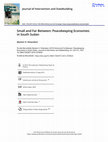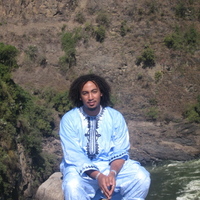Papers by Øystein H. Rolandsen
Journal of Intervention and Statebuilding, 2021
Security Force Assistance (SFA) – the training and equipping of a foreign security force – repres... more Security Force Assistance (SFA) – the training and equipping of a foreign security force – represent a common form of intervention into fragile states. This introduction assesses the state of the field of SFA research and focuses on dynamics specific to recipient states with fragmented security sectors. Based on insights from the contributions to the special issue we propose a framework for research which covers conceptualisation, implementation and impact of SFA programmes. The cases studied here emphasise that the logic of governance in many of these states relies upon manipulating security sector fragmentation, often producing outcomes directly opposed to SFA providers' intent.

The Sahel region is severely affected by Brief Points organised violence and an important focus a... more The Sahel region is severely affected by Brief Points organised violence and an important focus area for security force assistance (SFA). Such assistance aims to build the capacity of government forces to wage counter-insurgency and counter-terror campaigns, prevent organised crime, and control borders. This policy brief discusses challenges related to provision of SFA in the Sahel. It highlights the role of small states such as Belgium, Ireland and Sweden. These small states experience challenges concerning the impact and unintended consequences of their efforts, as well limited autonomy within larger coalitions. Such obstacles hamper the effectiveness of their SFA contributions. Looking at the provision of SFA between 2010 and 2018 in six countries in the Sahel region (Burkina Faso, Chad, Mali, Mauritania, Niger and Senegal), this brief summarises lessons learned and suggests ways to address future challenges.
Abyei Buram Kapoeta Nagishot * Final boundary between the Republic of Sudan and the Republic of S... more Abyei Buram Kapoeta Nagishot * Final boundary between the Republic of Sudan and the Republic of South Sudan has not yet been determined.
What are the conditions under which businesses can move beyond ‘doing no harm’ in the fragile an... more What are the conditions under which businesses can move beyond ‘doing no harm’ in the fragile and conflict-affected societies where they work to deliver more tangible positive peace dividends? Designed for businesses, practitioners, scholars and others who are interested and engaged in corporate impact in such areas, this report provides an overview of the main lessons from a four-year study of corporate peacebuilding initiatives across a range of contexts. Its main findings are formulated as seven key questions which can help evaluate risks and improve impact.

1. Introduction: Violence as politics in eastern Africa, 1940-1990 - legacy, agency, contingency ... more 1. Introduction: Violence as politics in eastern Africa, 1940-1990 - legacy, agency, contingency David M. Anderson and Oystein H. Rolandsen 2. Calm between the storms? Patterns of political violence in Somalia, 1950-1980 Ken Menkhaus 3. Political violence and the emergence of the dispute over Abyei, Sudan, 1950-1983 Luka B. Deng Kuol 4. "Unsound" minds and broken bodies: the detention of "hardcore" Mau Mau women at Kamiti and Gitamayu Detention Camps in Kenya, 1954-1960 Katherine Bruce-Lockhart 5. Discourses of violence in the transition from colonialism to independence in southern Sudan, 1955-1960 Oystein H. Rolandsen and Cherry Leonardi 6. Ethiopian state support to insurgency in Southern Sudan from 1962 to 1983: local, regional and global connections Lovise Aalen 7. Violence, decolonisation and the Cold War in Kenya's north-eastern province, 1963-1978 Daniel Branch 8. Remembering Wagalla: state violence in northern Kenya, 1962-1991 David M. Anderson 9. Ethiopian foreign policy and the Ogaden War: the shift from "containment" to "destabilization", 1977-1991 Belete Belachew Yihun 10. The Uganda-Tanzania War, the fall of Idi Amin, and the failure of African diplomacy, 1978-1979 George Roberts 11. The grassroots nature of counterinsurgent tribal militia formation: the case of the Fertit in Southern Sudan, 1985-1989 Daniel S. Blocq 12. Punishing the periphery: legacies of state repression in the Ethiopian Ogaden Tobias Hagmann
Journal of Peace Research, 2012
Journal of Peace Research, 2012

Politica Exterior, 2011
Despues de 22 anos de guerra civil en Sudan, el sur debe votar en enero el referendum sobre su po... more Despues de 22 anos de guerra civil en Sudan, el sur debe votar en enero el referendum sobre su posible secesion. Mas alla de diferencias de religion, etnia o las disputas por el petroleo, lo sucedido es una muestra de la incapacidad del debil y autoritario Estado sudanes. Los habitantes de Sudan del Sur estan llamados a votar este mes de enero el referendum sobre la independencia de esta region del pais. El referendum se interpreta como la conclusion del Acuerdo General de Paz entre el gobierno de Sudan y el Movimiento de Liberacion del Pueblo Sudanes. Sin embargo, el proceso de secesion ha cobrado demasiado impulso historico y politico para decidirse mediante este referendum. Los ciudadanos del sur y sus dirigentes no aceptaran un resultado oficial que no sea concluyente o que este a favor de la unidad. Siendo realistas, Sudan se enfrenta a dos futuros posibles: la secesion del sur o una nueva guerra entre norte y sur. La prueba final del proceso de paz sera, por tanto, la negociacion sobre las condiciones de la secesion de Sudan del Sur. El legado de 22 anos de guerra civil y la constante tension entre los antiguos enemigos hacen que un imprevisto aumento de la violencia y una nueva guerra sean amenazas constantes. La ayuda y la presion diplomatica de los paises vecinos y la comunidad internacional son importantes para que el proceso no descarrile pero, en ultima instancia, la conclusion pacifica depende de las partes en conflicto y de la capacidad de sus dirigentes para hacer gala de la habilidad politica necesaria a la hora de tomar decisiones dificiles.

South Sudan is the world's youngest independent country. Established in 2011 after two wars, ... more South Sudan is the world's youngest independent country. Established in 2011 after two wars, South Sudan has since reverted to a state of devastating civil strife. This book provides a general history of the new country, from the arrival of Turco-Egyptian explorers in Upper Nile, the turbulence of the Mahdist revolutionary period, the chaos of the 'Scramble for Africa', during which the South was prey to European and African adventurers and empire builders, to the Anglo-Egyptian colonial era. Special attention is paid to the period since Sudanese independence in 1956, when Southern disaffection grew into outright war, from the 1960s to 1972, and from 1983 until the Comprehensive Peace of 2005, and to the transition to South Sudan's independence. The book concludes with coverage of events since then, which since December 2013 have assumed the character of civil war, and with insights into what the future might hold.
South Sudan’s secession from Sudan on July 9th 2011 has changed the relative imbalance of power a... more South Sudan’s secession from Sudan on July 9th 2011 has changed the relative imbalance of power and international standing of the two parties, bringing South Sudan more on par with Sudan. Compared to the negotiations preceding the 2005 Comprehensive Peace Agreement, less is at stake in the current AUHIP process.
Journal of Eastern African Studies, 2015
Popular explanations for the outbreak of a new civil war in South Sudan have centred on ethnic fa... more Popular explanations for the outbreak of a new civil war in South Sudan have centred on ethnic factors and leadership personalities. This article demonstrates that the conflict is rooted in deep cleavages within the ruling political party, the Sudan People's Liberation Movement (SPLM). When internal tensions came to a head in late 2013, a combination of neopatrimonial politics, a weak state structure and legacies of violence from the previous civil war allowed this to escalate into a full-scale armed conflict.

Journal of Eastern African Studies, 2014
Over the 50 years between 1940 and 1990, the countries of eastern Africa were embroiled in a rang... more Over the 50 years between 1940 and 1990, the countries of eastern Africa were embroiled in a range of debilitating and destructive conflicts, starting with the wars of independence, but then incorporating rebellion, secession and local insurrection as the Cold War replaced colonialism. The articles gathered here illustrate how significant, widespread and dramatic this violence was. In these years, violence was used as a principal instrument in the creation and consolidation of the authority of the state, and it was also regularly and readily utilised by those who wished to challenge state authority through insurrection and secession. Why was it that eastern Africa should have experienced such extensive and intensive violence in the 50 years before 1990? Was this resort to violence a consequence of imperial rule, the legacy of oppressive colonial domination under a coercive and non-representative state system? Did essential contingencies such as the Cold War provoke and promote the use of violence? Or was it a choice made by Africans themselves and their leaders, a product of their own agency? This article focuses on these turbulent decades, exploring the principal conflicts in six key countries – Kenya, Uganda, Sudan, Ethiopia, Somalia and Tanzania.

Journal of Intervention and Statebuilding, 2015
The massive expenditure on UN peacekeeping missions combined with a significant commitment of per... more The massive expenditure on UN peacekeeping missions combined with a significant commitment of personnel and infrastructure creates 'peacekeeping economies' within host societies. We need to understand when and how peacekeeping economies are created and the kinds of factors that mitigate their occurrence, size and impact. Previous research indicates an overall tendency of UN missions to minimize involvement in host communities' economies, and considerable variation in the level of economic impact. Especially in insecure environments, the modalities of UN peacekeeping limit the level of economic interaction with host societies. South Sudan is a case in point. Annually about 10,000 people are employed and $1 billion on average spent on peacekeeping in South Sudan. However, at both the macro and micro levels the economic impact of peacekeeping has been overshadowed by the concurrent influx of oil revenue. Oil money has created a boom in the larger towns that dwarfs the impact of peacekeeping activities. The lack of domestic markets and skilled labour reduces opportunities for the missions, and their foreign personnel, to engage in economic transactions with South Sudanese.

International Area Studies Review, 2015
The new civil war in South Sudan began in December 2013. It soon proved to be a disaster for the ... more The new civil war in South Sudan began in December 2013. It soon proved to be a disaster for the population, a threat to the integrity of the world’s youngest state and an embarrassment and conundrum to the international community. The article surveys the first year of this war. It outlines the course of military engagements, the consequences of the war for the people of South Sudan and the ways in which a peaceful settlement has been sought. During 2014 external initiatives and threats of sanctions were employed to prod the warring parties into a productive process, but with only limited success because each side entrenched itself while waiting for the other to collapse. Developments in January 2015 indicate that the time might be ripe for a negotiated settlement: the parties have reached military stalemate and negotiations have sketched the contours of a settlement. What remains is the haggling over the finer points of a political compromise. However, mediators and the parties mus...
The Borderlands of South Sudan

Journal of Peace Research, 2007
Joseph Kony’s Lord’s Resistance Army (LRA) is regarded as a prime example of insurgency groups co... more Joseph Kony’s Lord’s Resistance Army (LRA) is regarded as a prime example of insurgency groups conducting ‘meaningless’ violence in Africa’s ‘new’ civil wars. In those wars, rebellions have been understood as societal diseases that should be combated with new, apolitical cures. The International Criminal Court (ICC) is one of these cures, and the LRA conflict in Northern Uganda is one of the test cases. In 2005, following a long investigation, five warrants were issued for the top leaders of the LRA. The role of the ICC in Uganda has, however, proved controversial, at both the local and international levels. Tim Allen’s Trial Justice presents, in a convincing manner, the history of the conflict in Northern Uganda, with its spillover effects in Sudan, and the background for the ICC’s involvement. The strength of the book lies in the manner in which Allen utilizes his comprehensive research into the lives of former LRA combatants, the consequences of the conflict for the civilian population, and these groups’ attitudes towards the LRA, the ICC and the ongoing peace process. Important in this regard is Allen’s ability to enter the local discourse and analyse debates taking place at the grassroots level. Convincingly, he fleshes out the opposition between reconciliation and prosecution and demonstrates how the ICC, with its warrants on the chief negotiators from the LRA side, may be seen as spoilers to the peace process. Like the other books in the African Arguments series, Trial Justice is aimed at a broader audience and is first and foremost an apt contribution to an important and complex debate. Øystein Rolandsen
Journal of Peace Research, 2009
Journal of Peace Research, 2009
Journal of Peace Research, 2008











Uploads
Papers by Øystein H. Rolandsen
This book was published as a special issue of the Journal of Eastern African Studies.